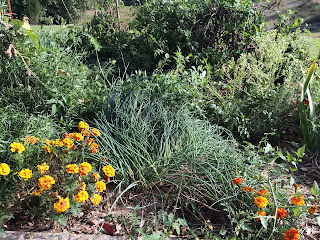Sunday, January 29, 2023
When I started my first edible garden, it was with herbs interplanted in my flower bed. Herbs are pricey in the store and a single plant can give all you and your friends need for a year from one harvest. Plus, most are perennials and thrive on neglect. What's not to love? The next step in the edible garden journey was buying plants from the local nursery. Nurseries carry the most popular varieties. As I expanded to seeds, the catalogs had all kinds of unique fruits and vegetables you could grow. I have been trying a few "unusual" varieties that grow from seed for several years now.
Here are ones that have become standbys in my garden and why:
Trombetta squash-this variety can be eaten like zucchini or can be stored as you would a winter squash. Plus, it seems totally pest and practically disease free and extremely productive all the way to a hard freeze. On the downside, the vines can run up to 20' long so give them room to roam!
Egyptian walking onions-these onions are the size of leeks, can be grown in the ground or in a pot, spread through division underground and by bulbets that grow at the top of their stems in June that can be replanted. They are extremely hardy. I got my start from a lady in Kansas that had a B&B. She kept hers in a pot year round outside. The bulb has the taste of white onions, the green leaves can be used as chives and they self-propagate so you only have to plant them one time and harvest from them year round.
Winged or yard long beans-I grow these in addition to the purple podded roma vines. I love the winged beans for their beautiful blue flowers. The beans themselves have an asparagus taste. They are best grown in regions that have a long summer season as it takes a bit for them to produce. Yard long beans are extremely productive and seem to be disease and pest resistant. They do have a long vine so give it a nice sized trellis to grow on. They come in green, red or purple colored pods. They are great sautéed.
Cardinal and Nuun basil-I love Cardinal basil for its beautiful burgundy "flowers" and Nuun basil for its strong fragrance and self-seeding habit. Both can be used for pesto. I grow enough basil to keep us in pesto year round. I make it a couple times during the summer and fall, freezing it to break out the rest of the year. I brought some Nuun basil inside that had taken up residence in pots. There is one plant that is still going. The rest gave up after going to seed. They just smell so good!
Cherokee Purple, Chocolate Pear, Indigo Pear Drop and Italian Red Pear paste tomatoes-I grow the first 3 as they seem to always do well in my garden. You can easily get Cherokee Purple tomatoes at the big box stores these days so it's not really an "unusual" variety any more. I love the Italian Red Pear paste tomato because the fruits are huge and it gives such silky sauce. They take the longest of any tomato variety I grow to get to harvestable tomatoes, but they are worth the wait. I put at least one of these paste tomatoes in every quart of frozen tomatoes I put up so they are in any dish I use frozen tomatoes to prepare.
Orach, Amaranth, Chinese cabbage, and Red Malabar spinach for salads-because we have such hot, humid summers here and I love salads, I have branched out from just traditional spinach and lettuce for salad greens to enable salads all summer long. I grow a variety of colors of orach, Chinese Multi-Colored Spinach amaranth, Love Lies Bleeding amaranth, Chinese Hilton cabbage and Red Malabar spinach in addition to the most heat tolerant lettuces I have found to keep our summer salads going. Love Lies Bleeding is a really striking plant grown for its seed heads. You can harvest the seeds to use as a grain. Red Malabar spinach has a pretty burgundy vine and berries, a beautiful burgundy flower and likes to self-seed. I brought 2 indoors for the winter and they are both still going.
Tigger melon-it has the taste of cantaloupe, but is a small fruit that it just right for one or two people, its fruits ripen over time versus all at once so you aren't overwhelmed with 20 cantaloupes to eat at once, it's fruit is cute and it is tasty.
Don't be afraid to try something new or unusual. Try just one new variety each season. I look for descriptions that address a need I have; whether it be pest/disease resistance, giving lots of food per plant, able to handle our hot summers or just for their beautiful foliage and flowers. Doing so has given me more food from the same space and time with crops that require less from me.











